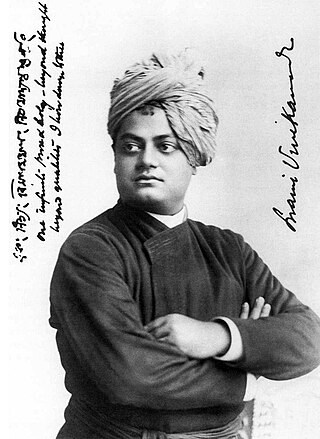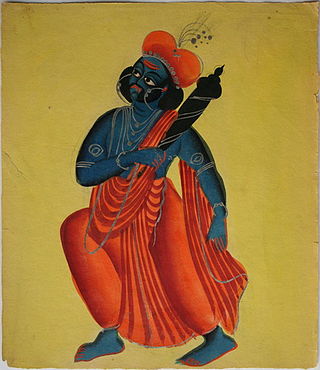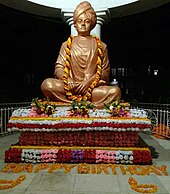
Swami Vivekananda, born Narendranath Datta, was an Indian Hindu monk, philosopher, author, religious teacher, and the chief disciple of the Indian mystic Ramakrishna. He was a key figure in the introduction of Vedanta and Yoga to the Western world, and the father of modern Indian nationalism who is credited with raising interfaith awareness and bringing Hinduism to the status of a major world religion.

Youth Day or National Youth Day is a commemorative holiday in honour of young people, celebrated in different parts of the world on various dates throughout the year.

Ramakrishna, also called Ramakrishna Paramahansa, born RamakrishnaChattopadhay, was an Indian Hindu mystic. He was a devotee of the goddess Kali, but adhered to various religious practices from the Hindu traditions of Vaishnavism, Tantric Shaktism, and Advaita Vedanta, as well as from Islam and Christianity. He advocated the essential unity of religions and proclaimed that world religions are "so many paths to reach one and the same goal". His parable-based teachings espoused the ultimate unity of diverse religions as being means to enable the realization of the same God. He is regarded by his followers as an avatar.

Ramakrishna Math and Ramakrishna Mission (RKM) is a spiritual and philanthropic organisation headquartered in Belur Math, West Bengal. The mission is named after the Indian Hindu spiritual guru and mystic Ramakrishna. The mission was founded by Ramakrishna's chief disciple Swami Vivekananda on 1 May 1897. The organisation mainly propagates the Hindu philosophy of Vedanta–Advaita Vedanta and four yogic ideals – Jnana, Bhakti, Karma, and Raja yoga. The mission bases its work on the principles of Karma Yoga, the principle of selfless work done with a dedication to God.

Sister Nivedita was an Irish teacher, author, social activist, school founder and disciple of Swami Vivekananda. She spent her childhood and early youth in Ireland. She was engaged to marry a Welsh youth, but he died soon after their engagement.

Hanuman Jayanti is a Hindu festival celebrating the birth of the Hindu deity, and one of the protagonists of the Ramayana and its many versions, Hanuman. The celebration of Hanuman Jayanti varies by time and tradition in each state of India. In most northern states of India, the festival is observed on the full-moon day of the Hindu month of Chaitra. In Karnataka, Hanuman Jayanti is observed on Shukla Paksha Trayodashi, during the Margashirsha month or in Vaishakha, while in a few states like Kerala and Tamil Nadu, it is celebrated during the month of Dhanu. Hanuman Jayanti is observed on Pana Sankranti in the eastern state of Odisha, which coincides with the Odia New Year.

Vivekananda Rock Memorial is a monument and popular tourist attraction in Kanyakumari, India's southernmost tip. The memorial stands on one of the two rocks located about 500 meters off mainland of Vavathurai. It was built in 1970 in honour of Swami Vivekananda, who is said to have attained enlightenment on the rock. According to legends, it was on this rock that Goddess Kanyakumari (Parvathi) performed tapas in devotion of lord Shiva. A meditation hall known as Dhyana Mandapam is also attached to the memorial for visitors to meditate. The design of the mandapa incorporates different styles of temple architecture from all over India. The rocks are surrounded by the Laccadive Sea where the three oceans Bay of Bengal, the Indian Ocean and the Arabian Sea meets. The memorial consists of two main structures, the Vivekananda Mandapam and the Shripada Mandapam.

Ramakrishna Mission Vidyalaya, Coimbatore is a group of educational institutions with 19 wings offering courses from pre-school to doctoral levels. The Vidyalaya was established in 1930 in the suburbs of Coimbatore, India, and affiliated to Ramakrishna Mission in 1934. Ramakrishna Mission's official General Reports start giving reports of its activities from 1936.

P. Parameswaran, often referred to as Parameswarji, was a Rashtriya Swayamsevak Sangh (RSS) pracharak from Kerala, India who was erstwhile Vice‑President of the Jan Sangh.
The Indians in Fiji are mainly descendants of the 15,132 contract labourers who were brought to Fiji between 1903 and 1916. This represents about 25% out of a total of 60,965 contract labourers who were brought to Fiji between 1879 and 1916. They were forced in to ships from Madras and were mainly recruited in the districts of North Arcot, Madras, Krishna, Godavari, Visakhapatnam, Tanjore, Malabar and Coimbatore. More than half of the labourers from South India were recruited from North Arcot and Madras, but most of those recruited in Madras were originally from North Arcot and Chingleput.

Sri Ramakrishna Math, Chennai is a monastic organisation for those men who were taught into existence by Sri Ramakrishna (1836–1886), a 19th-century saint of Bengal. The motto of the Ramakrishna Math and Ramakrishna Mission is: "For one's own salvation, and for the welfare of the world". The math in Chennai is the first branch center of the Ramakrishna Order in Southern India. It was established in 1897 by Swami Ramakrishnananda, one of the direct disciples of Sri Ramakrishna. Besides Swami Ramakrishnananda, the Math was visited by Holy Mother Sri Sarada Devi, Swami Nirmalananda, Swami Shivananda, Swami Abhedananda, Swami Premananda, Swami Niranjanananda, Swami Trigunatitananda, and Swami Vijnanananda.

Josephine MacLeod was an American friend and devotee of Swami Vivekananda. She had a strong attachment to India and was an active participant in the Ramakrishna Vivekananda movement. She was given the nicknames "Tantine" and "Jo Jo" by Vivekananda. She considered Swami Vivekananda to be her friend and helped him with his finances. MacLeod was not a sanyasin, unlike many others such as Sister Nivedita or Sister Christine. She was instrumental in spreading Vivekananda's message on Vedanta in the West. She made many contributions to the initial and the later phases of the development of the order of Ramakrishna and Vivekananda. She was a contributor to many causes espoused by Sister Nivedita, the most famous disciple of Vivekananda, including that of contributing financially towards the development of the Indian National Movement especially in Bengal and elsewhere in India.

Khandana Bhava–Bandhana, Sri Ramakrishna Aratrikam, or Sri Ramakrishna Arati, is a Bengali song composed by Hindu monk Swami Vivekananda. The song, dedicated to the 19th-century saint Ramakrishna, was composed in 1898. Khandana Bhava-Bandhana is a prayer song based on Raga Mishra Kalyani, Tala Ferta used in Indian classical music.

Swami Vivekananda was an Indian Hindu monk. He was a key figure in the introduction of the Indian philosophies of Vedanta and Yoga to the western world. The 150th birth anniversary of Swami Vivekananda was celebrated all over India and in different countries in the world. Ministry of Youth Affairs & Sports of India decided to observe 2013 as the year of 150th Birth Anniversary of Swami Vivekananda. Year-long events and programs were organised by different branches of Ramakrishna Math, Ramakrishna Mission, central government and different state governments of India, education institutions, youth groups etc. Bengali film director Tutu (Utpal) Sinha made a film The Light: Swami Vivekananda as a tribute to Swami Vivekananda on his 150th birth anniversary. The movie was released on 23 August 2013.

"Arise awake and stop not till the goal is reached." is a slogan popularized in the late 19th century by Indian Hindu monk Swami Vivekananda, who took inspiration in a sloka of Katha Upanishad. It was his message to the world to get out of their hypnotized state of mind. This shloka is the basis of the title of the book The Razor's Edge and the 1946 film and the 1984 film, and also of various music albums in the west by bands like AC/DC, Dave Holland, etc.

Swami Vivekananda, the nineteenth-century Indian Hindu monk, is considered one of the most influential people of modern India and Hinduism. Rabindranath Tagore suggested to study Vivekananda's works to learn about India. Indian independence activist Subhas Chandra Bose regarded Vivekananda as his spiritual teacher. Mahatma Gandhi said that after reading the works of Vivekananda, his love for his nation became a thousand-fold.
Swami Vivekananda Youth Employment Week was a weeklong youth employment festival organized in Gujarat, India, in April 2012. During this week, Narendra Modi, Chief Minister of Gujarat, handed job appointment letters to 65,000 youths. The event was organized as a part of the 150th birth anniversary of Swami Vivekananda celebrations in the state.
Alambazar Math is the second monastery of the Ramakrishna Order established in February 1892, which remained the order's headquarters till February 1898, when it was finally moved to Belur village on the bank of Ganga.

Baranagore Ramakrishna Mission Ashrama High School (H.S.) (BRKMAHS) is a senior secondary boys' school in Baranagar, Kolkata, India and a branch centre of Ramakrishna Math and Ramakrishna Mission, Belur Math. The school was founded in 1912, and is located at the northern outskirt of Kolkata, on the banks of the river Ganga. The school is run by the Baranagar Ramakrishna Mission Ashrama Authority under the umbrella of Ramakrishna Mission headquartered at Belur Math. Based on its performance of the students in the Xth standard board examination, the school is considered one of the very best schools in West Bengal. Department of Tourism listed it as one of the tourist spots of West Bengal.
In 1888, Swami Vivekananda left the monastery as a Parivrâjaka— the Hindu religious life of a wandering monk, "without fixed abode, without ties, independent and strangers wherever they go". His sole possessions were a kamandalu, staff and his two favourite books: the Bhagavad Gita and The Imitation of Christ. Narendra travelled extensively in India for five years, visiting centres of learning and acquainting himself with diverse religious traditions and social patterns. He developed sympathy for the suffering and poverty of the people, and resolved to uplift the nation. Living primarily on bhiksha (alms), Swami Vivekananda travelled on foot and by railway. During his travels he met, and stayed with Indians from all religions and walks of life: scholars, dewans, rajas, Hindus, Muslims, Christians, paraiyars and government officials.














